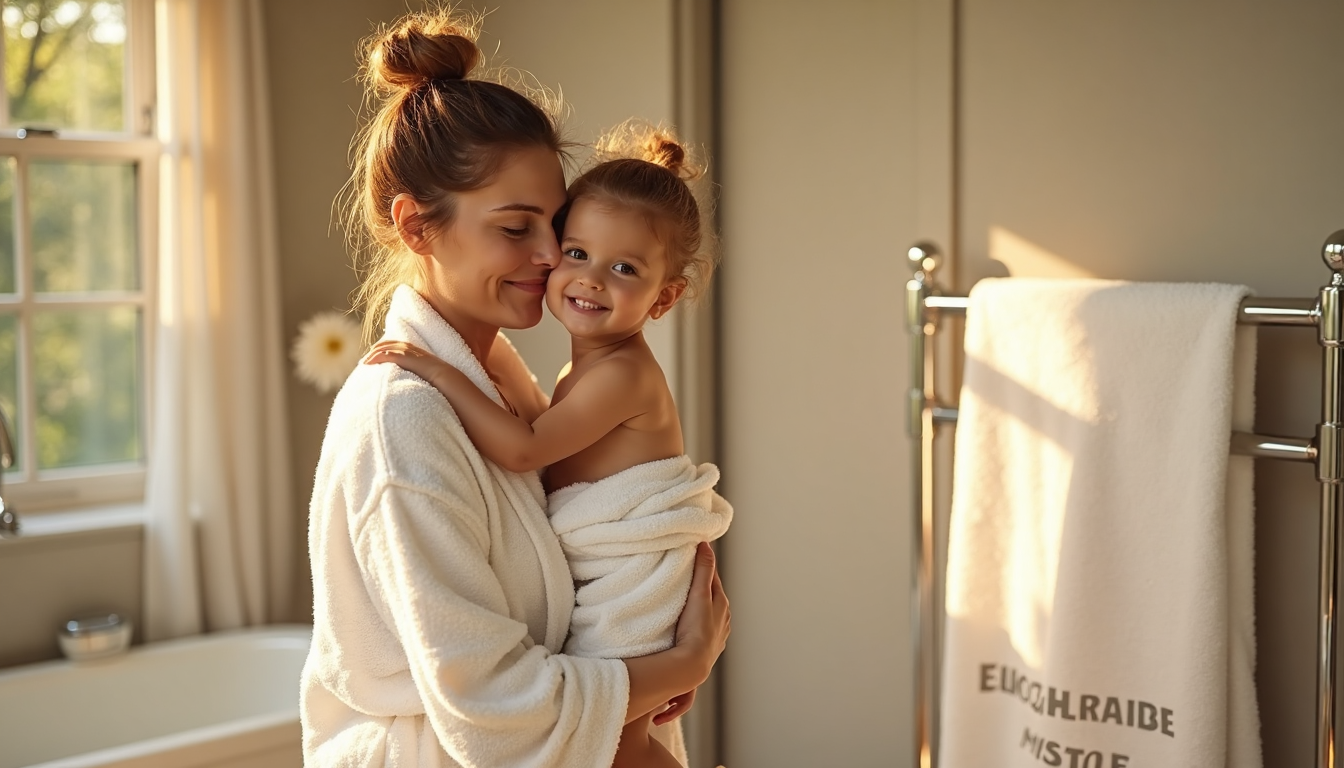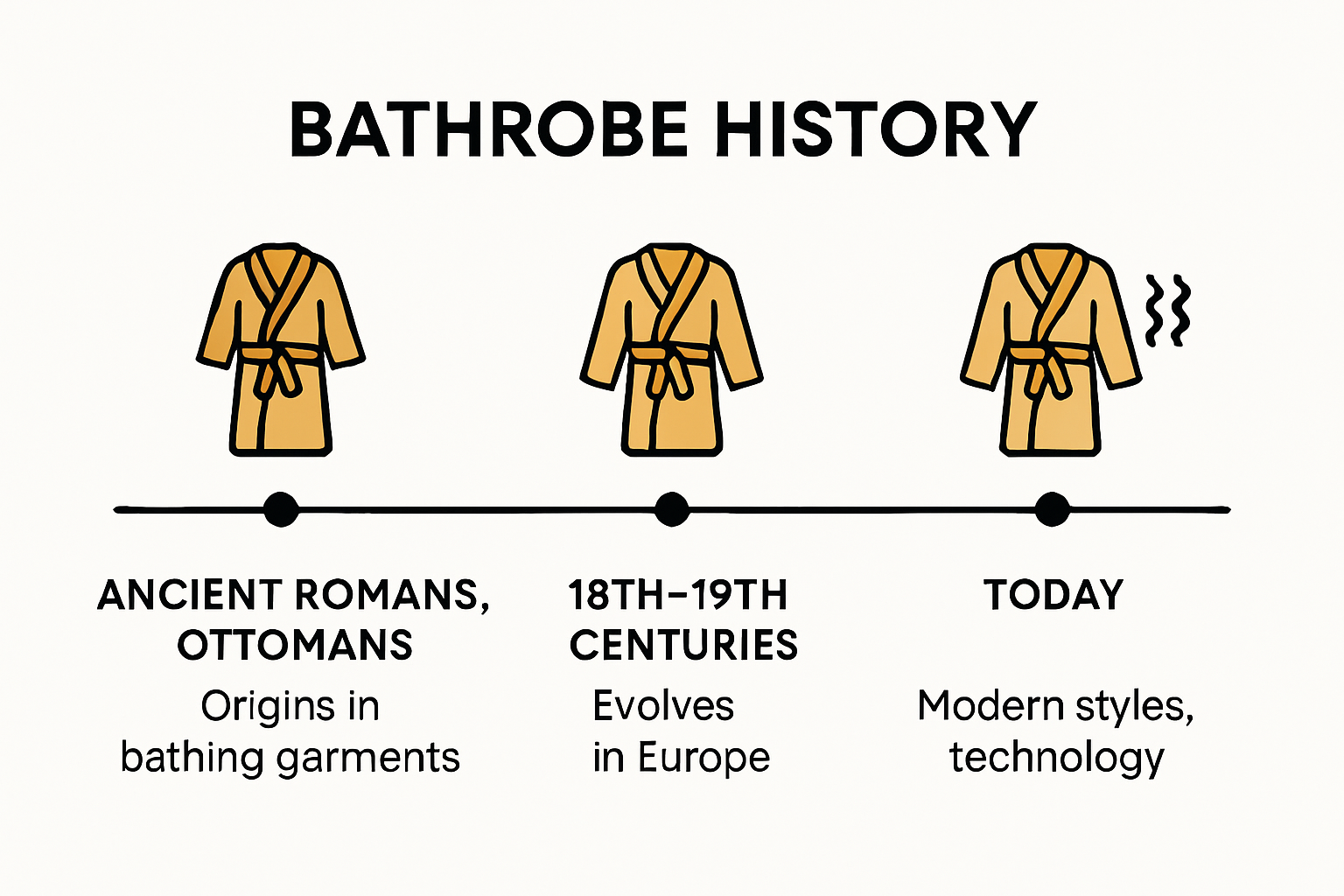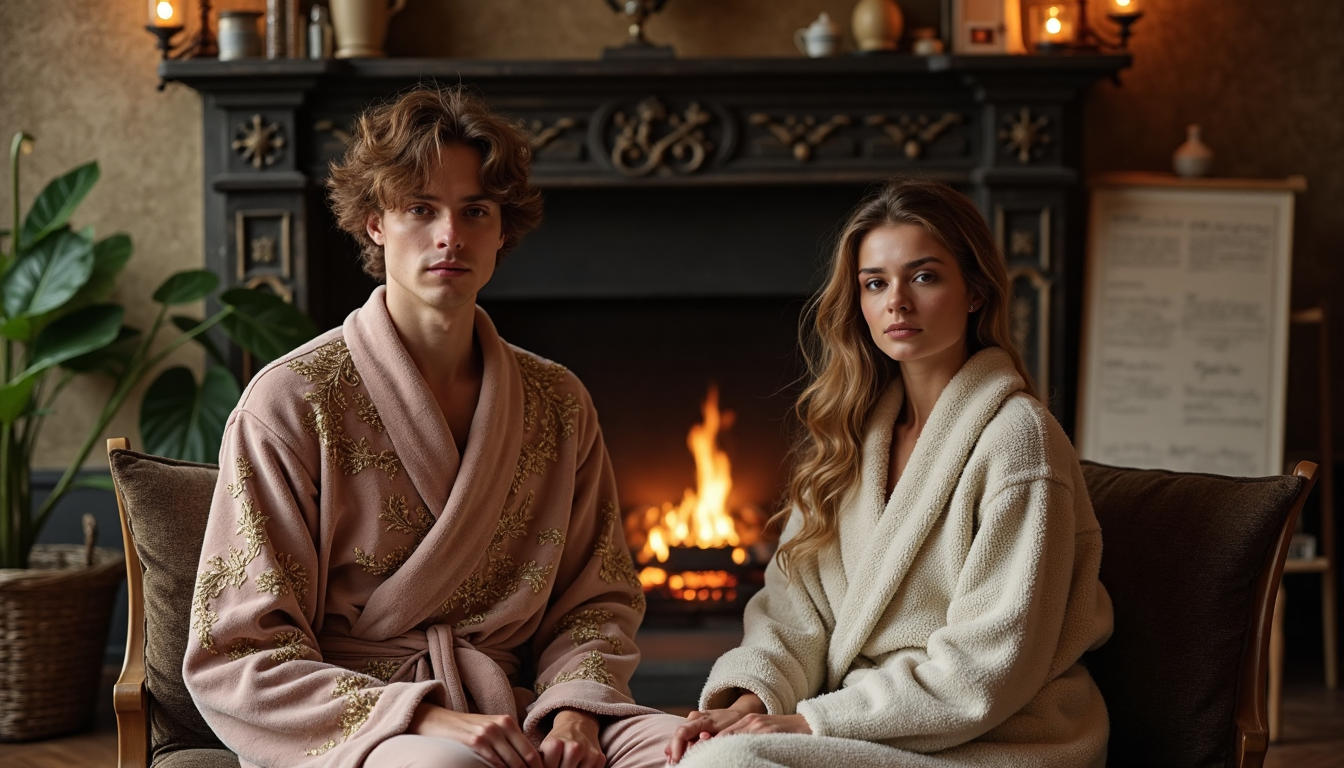
Bathrobes have come a long way since their modest beginnings in ancient Rome and Ottoman hammams. Here is something you probably did not know. The luxury bathrobe market is projected to reach USD 2.8 billion by 2028, fueled by high-tech fabrics and soaring demand for personalization. Most people think of bathrobes as simple after-shower garments, but their story is packed with cultural twists, secret fabric innovations, and a surprisingly fierce competition for comfort.
Table of Contents
- Bathrobe History: Origins Across Cultures
- Bathrobes Through The Ages: Styles And Fabrics
- Bathrobes Today: Design, Luxury, And Personalization
- Choosing The Perfect Bathrobe: Tips For Every Need
Quick Summary
| Takeaway | Explanation |
|---|---|
| Cultural Origins | Bathrobes have diverse historical roots across various cultures, evolving from simple wraps in ancient Rome and Ottoman hammams to modern loungewear, highlighting a universal quest for comfort and modesty post-bathing. |
| Fabric Innovation | The Industrial Revolution democratized bathrobes, making luxurious materials like terry cloth accessible to middle-class households, fundamentally changing the availability and experience of post-bathing garments. |
| Modern Features | Today’s bathrobes utilize advanced textile technologies, including moisture-wicking and antimicrobial properties, catering to contemporary consumer demands for enhanced performance and comfort in personal attire. |
| Personalization Trends | Modern consumers increasingly prefer customized bathrobes that reflect their personal style and preferences, prompting luxury brands to offer bespoke options ranging from fabric selection to personalized embroidery. |
| Choosing Wisely | When selecting a bathrobe, consider factors such as material performance, personal style, intended use, and maintenance requirements to find a garment that enhances comfort and aligns with your lifestyle. |
Bathrobe History: Origins Across Cultures
Bathrobes represent more than just a garment. They are a testament to human comfort, cultural practices, and the universal desire for warmth and relaxation after bathing. The origins of bathrobes stretch across diverse civilizations, each contributing unique elements to what we now recognize as a standard piece of loungewear.

Ancient Roots of Bathing Attire
The concept of post-bathing comfort has deep historical roots. In ancient Rome, citizens developed sophisticated bathing cultures that required appropriate garments. While not precisely bathrobes as we know them today, togas and simple wraps provided coverage and warmth after communal bathing experiences. These early garments demonstrated a fundamental human need for comfort and modesty.
The Ottoman Empire elevated bathing culture to an art form. Historical records reveal that hammams (public bathhouses) were social centers where lightweight peshtemals (traditional towel wraps) gradually evolved into more substantial robes. These early predecessors were crafted from absorbent, lightweight materials designed to provide comfort and quick drying after intense steam and washing rituals.
Cultural Transformations of Bathing Garments
Each culture developed unique approaches to post-bathing attire. In Japan, the yukata emerged during the Edo period as a remarkable example of functional yet elegant design. Japanese cultural historians note that these lightweight cotton kimonos were initially worn after bathing in communal hot springs, representing a perfect blend of practicality and cultural aesthetics.
The evolution of bathrobes reflects more than just textile development. It represents a global understanding of personal comfort and the ritualistic nature of bathing. From the Turkish hammams to Japanese onsen, these garments transformed from purely functional items to symbols of relaxation and self-care.
The Global Journey to Modern Bathrobes
By the 19th century, bathing practices in Europe and North America began standardizing personal hygiene routines. Textile research indicates that this period saw significant innovations in fabric technology and clothing design. Wealthy households started incorporating more luxurious bathing garments, often made from terry cloth and other absorbent materials.
The industrial revolution played a crucial role in democratizing bathrobes. Mass production techniques made these once-exclusive garments accessible to middle-class households. What was once a luxury item became a standard piece of home comfort, bridging social and economic divides through a simple, functional design.
Today’s bathrobes are a global product, incorporating design elements from various cultural traditions. They represent a universal human desire for comfort, warmth, and a moment of personal relaxation after the daily rhythms of life. From ancient Roman bathhouses to modern spa retreats, the bathrobe continues to evolve, telling a rich story of human comfort and cultural exchange.
Bathrobes Through the Ages: Styles and Fabrics

The story of bathrobes is a fascinating journey through textile innovation, cultural expression, and changing social norms. Each era brought distinctive styles and fabrics that transformed these garments from simple functional coverings to sophisticated expressions of personal comfort and style.
Aristocratic Elegance and Early Fabric Innovations
In the 17th and 18th centuries, European aristocracy established a remarkable precedent for luxurious loungewear. Historical fashion archives reveal that dressing gowns became symbols of wealth and sophistication. Wealthy individuals adorned themselves in elaborate robes crafted from brocade, velvet, and silk, often featuring intricate embroidery and elaborate designs.
The Turkish hammam tradition introduced revolutionary textile concepts. Textile historians document how peshtemals - lightweight, highly absorbent wraps made from fine cotton and linen - represented an early prototype of functional bathing attire. These garments were not just practical but also reflected the refined bathing cultures of the Ottoman Empire.
Industrial Revolution and Fabric Democratization
The Industrial Revolution marked a transformative period for bathrobe development. Textile manufacturing research indicates that mechanized production dramatically changed fabric accessibility and quality. Terry cloth emerged as a game-changing material, offering unprecedented absorbency and comfort.
Manufacturers began producing bathrobes using cotton terry cloth, making these once-exclusive garments affordable for middle-class households. This shift represented more than a technological advancement. It symbolized a democratization of comfort, allowing more people to experience the luxury of soft, absorbent post-bathing wear.
Modern Fabric and Style Diversity
Contemporary bathrobes showcase an incredible range of materials and designs. Textile innovation studies reveal fascinating developments in fabric technology. Modern bathrobes incorporate materials like microfiber, bamboo blends, and performance fabrics that offer enhanced moisture-wicking and temperature regulation.
Today’s bathrobes range from lightweight waffle weave designs perfect for warm climates to plush, heavyweight options ideal for colder environments. Designers now consider not just functionality but also aesthetic appeal, creating robes that serve as both practical garments and fashion statements.
From the ornate silk robes of European nobility to the practical terry cloth versions of the 20th century, and now the high-tech, performance-oriented designs of today, bathrobes tell a rich story of human creativity, technological progress, and our enduring quest for comfort.
Here is a table summarizing the key fabrics and style features of bathrobes throughout different historical periods, highlighting their evolution and distinctive characteristics:
| Era/Tradition | Typical Fabric(s) | Style/Characteristics |
|---|---|---|
| Ancient Rome | Wool, Linen | Togas, simple wraps for coverage & warmth |
| Ottoman Empire (Hammam) | Cotton, Linen (Peshtemals) | Lightweight, absorbent, fast-drying wraps |
| Japan (Edo Period) | Cotton (Yukata) | Casual kimono shape, practical & elegant |
| 17th-18th C. European Aristocracy | Brocade, Velvet, Silk | Ornate dressing gowns, embroidery, luxurious |
| Industrial Revolution (19th-20th C.) | Cotton Terry Cloth | Highly absorbent, affordable, democratized |
| Modern (21st C.) | Microfiber, Bamboo Blends, Performance Fabrics | Moisture-wicking, thermal regulation, varied aesthetics |
Bathrobes Today: Design, Luxury, and Personalization
In the contemporary landscape of personal comfort, bathrobes have transcended their original functional purpose to become sophisticated expressions of style, wellness, and individual identity. The modern bathrobe represents a complex intersection of technology, design innovation, and personal preference.
Technological Advancements in Bathrobe Design
Market research indicates the luxury bathrobe market is projected to reach USD 2.8 billion by 2028, driven by significant technological innovations. Contemporary bathrobes now incorporate advanced textile technologies that go far beyond traditional absorption. Performance fabrics have revolutionized the bathrobe experience, introducing features like moisture-wicking capabilities, antimicrobial properties, and rapid drying technologies.
Textile innovation studies reveal fascinating developments in fabric engineering. Materials like bamboo blends, microfiber, and performance synthetics offer enhanced comfort, temperature regulation, and durability. These innovations respond to consumers’ increasing demand for garments that provide both exceptional comfort and functional benefits.
Personalization and Luxury Trends
Personalization has emerged as a defining trend in modern bathrobe design. Consumer behavior research demonstrates a growing preference for customized products that reflect individual style and personality. Consumers now seek bathrobes with monogrammed initials, personalized embroidery, and unique design elements that transform these garments from mere clothing items to personal statements.
Luxury brands have responded by offering increasingly sophisticated customization options. From selecting specific fabric weights to choosing intricate embroidery designs, consumers can now create bathrobes that are truly unique. This trend reflects a broader shift towards personalized, meaningful consumer experiences where products are not just purchased but curated.
Wellness and Lifestyle Integration
Today’s bathrobes are deeply integrated into holistic wellness and lifestyle concepts. Wellness industry reports highlight how bathrobes have become essential elements of self-care rituals. They are no longer just post-bathing garments but symbols of relaxation, personal sanctuary, and mental well-being.
Designers are creating bathrobes that complement various lifestyle contexts—from spa-inspired home environments to high-end hospitality settings. The modern bathrobe serves multiple purposes: a comfort tool, a fashion statement, and a personal wellness accessory. Sustainable manufacturing practices, ethical sourcing, and environmentally conscious production have also become critical considerations for consumers seeking bathrobes that align with their values.
The evolution of bathrobes reflects our changing relationship with comfort, technology, and personal expression. From simple cloth wraps to high-tech, personalized garments, bathrobes continue to adapt, mirroring the complex, multifaceted nature of contemporary human experience.
Choosing the Perfect Bathrobe: Tips for Every Need
Selecting the ideal bathrobe is a nuanced process that goes beyond simple aesthetic preferences. It involves understanding personal needs, lifestyle considerations, and the complex interplay between fabric performance, comfort, and individual requirements.
Understanding Fabric Performance and Comfort
Textile performance research reveals that fabric selection is critical in determining bathrobe comfort. Different materials offer unique thermal and moisture management properties that significantly impact wearer experience. ASTM standards provide comprehensive guidelines for evaluating fabric quality, emphasizing factors like breaking strength, tearing resistance, and colorfastness.
Consider your primary use case when selecting a bathrobe. For tropical or humid climates, lightweight materials with excellent moisture-wicking properties are ideal. Conversely, colder environments demand thicker, more insulating fabrics that retain body heat. Microfiber, cotton terry, and bamboo blends each offer distinct advantages depending on your specific needs.
Here is a comparison table outlining the performance and comfort features of key bathrobe fabrics mentioned in the article. This can help readers quickly assess which type might work best for their climate and preferences:
| Fabric Type | Absorbency | Thermal Warmth | Moisture-Wicking | Weight | Notable Features |
|---|---|---|---|---|---|
| Cotton Terry | High | Moderate-High | Moderate | Medium-Heavy | Classic, soft, great for drying |
| Microfiber | Moderate | Moderate | High | Lightweight | Quick-drying, soft texture |
| Bamboo Blend | High | Moderate | High | Lightweight | Antimicrobial, eco-friendly |
| Waffle Weave | Moderate | Light | Moderate | Lightweight | Breathable, fast-drying |
| Silk/Brocade/Velvet | Low | Moderate | Low | Lightweight/Heavy | Luxurious, ornate, elegant |
Lifestyle and Personal Preference Considerations
User experience research demonstrates that aesthetic appeal plays a crucial role in clothing satisfaction. Your bathrobe should not just feel comfortable but also reflect your personal style and complement your home environment. Consider factors like weight, texture, color, and design that align with your lifestyle and personal aesthetic.
For individuals with specific requirements, specialized bathrobes can make a significant difference. Athletes might prefer quick-drying, lightweight materials, while those seeking ultimate relaxation might opt for plush, heavyweight robes. Parents might prioritize easy-care fabrics, while spa enthusiasts might select luxurious, soft textures that enhance their relaxation experience.
Practical Selection Strategies
When choosing a bathrobe, consider multiple dimensions beyond immediate comfort. Length, sleeve style, and closure type can dramatically impact overall wearability. A knee-length robe offers more coverage, while a shorter version provides greater mobility. Shawl collars provide additional warmth, whereas kimono-style sleeves offer a more relaxed fit.
Pay attention to maintenance requirements. Some high-performance fabrics demand specialized care, while others are machine washable and low maintenance. Consider your willingness to invest time in garment care when making your selection. Durability, color retention, and ease of cleaning are as important as initial comfort.
Ultimately, the perfect bathrobe is a personal journey of discovering what makes you feel most comfortable, relaxed, and confident. By understanding fabric technologies, considering your lifestyle, and being mindful of practical considerations, you can find a bathrobe that transforms your daily routine into a moment of pure personal comfort.
Frequently Asked Questions
What is the historical origin of bathrobes?
Bathrobes trace their origins back to ancient civilizations such as Rome and the Ottoman Empire, where early forms included togas and lightweight peshtemals, designed for post-bathing comfort.
How have bathrobes evolved over time?
Bathrobes have transitioned from simple functional garments in ancient cultures to luxurious loungewear, with innovations in fabric technology and design enhancing comfort and style across different eras.
What materials are modern bathrobes made from?
Contemporary bathrobes use a variety of materials, including cotton terry, microfiber, bamboo blends, and performance fabrics, each offering distinct benefits such as moisture-wicking and temperature regulation.
How can I choose the right bathrobe for my needs?
When selecting a bathrobe, consider factors like fabric type, climate suitability, personal style, and maintenance requirements to find one that best enhances your comfort and lifestyle.
Experience Modern Luxury: Live the Bathrobe Evolution
Have you ever wondered how far comfort has come since the days of Roman togas and Ottoman peshtemals? The journey from ancient wraps to personalized luxury has taught us that simple fabric choices can transform daily routines into rituals of relaxation. Yet many people today still struggle to find a bathrobe that delivers true post-bathing comfort and fits both lifestyle and aesthetic needs. You deserve more than a generic, mass-produced garment. You should experience tailored softness, personalized beauty, and peace of mind every time you step out of the shower or settle in to unwind.

Stop settling for less. Discover how today’s leading textile innovations and customization options can finally meet your comfort expectations. Step inside Lotus Linen premium bathrobes and feel the difference of designs inspired by centuries of wellness and cultural tradition. Whether you want plush warmth, lightweight waffle weave, or a special custom touch, our collection lets you own your relaxation moment. Your journey to a new kind of luxury starts at shoplotuslinen.com. Choose your robe now and experience history’s ultimate comfort upgrade today.
Recommended
-
[ Why Use Bathrobes? Comfort, Style & Gift Trends for 2025
– Lotus Linen
](https://www.shoplotuslinen.com/blogs/news/why-use-bathrobes-comfort-luxury-gift-trends-2025)
-
[ Top 10 Most Luxurious Bathrobes
– Lotus Linen
-
[ History of Bathrobes
– Lotus Linen
](https://www.shoplotuslinen.com/blogs/news/the-history-of-bathrobes-from-ancient-times-to-modern-day)
-
[ Best Towels & Bathrobes
– Lotus Linen
](https://www.shoplotuslinen.com/blogs/news/ultimate-guide-on-how-to-choose-best-towels-and-bathrobes)
-
[ Unique Bathrobe Designs
– Lotus Linen
](https://www.shoplotuslinen.com/blogs/news/the-most-unique-bathrobe-designs-you-havent-seen-before)
-
[ Buying A Customized Bathrobe
– Lotus Linen
](https://www.shoplotuslinen.com/blogs/news/what-you-need-to-know-before-buying-a-customized-bathrobe)
